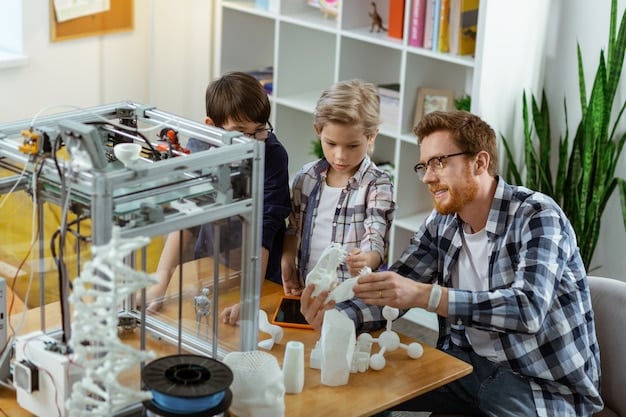How Will the US Address the Skills Gap in Manufacturing?

How will the US address the growing skills gap in the manufacturing sector? It will involve a multi-faceted approach including investments in vocational training, apprenticeships, educational programs, and public-private partnerships to equip workers with the necessary skills for modern manufacturing jobs.
The United States manufacturing sector is facing a significant challenge: a widening skills gap. This gap threatens to hinder economic growth and innovation. How will the US address the growing skills gap in the manufacturing sector? This article explores the various strategies and initiatives being implemented to bridge this critical gap and ensure the future competitiveness of American manufacturing.
Understanding the Manufacturing Skills Gap in the US
To understand how the US will address the growing skills gap in the manufacturing sector, it’s crucial to first understand what it is and how it came to be. The skills gap refers to the mismatch between the skills employers need and the skills that available workers possess. This mismatch is particularly acute in the manufacturing sector, with many companies struggling to find qualified candidates to fill open positions. This shortage impacts productivity, innovation, and overall economic growth.
What Factors Contribute to the Skills Gap?
Several factors contribute to the growing skills gap in manufacturing. These include technological advancements, an aging workforce, and a perception problem regarding manufacturing careers. Technology is rapidly changing the nature of manufacturing jobs. As automation, robotics, and advanced manufacturing techniques become more prevalent, workers need new skills to operate and maintain these technologies. However, the existing educational and training systems have not kept pace with these changes, leaving many workers without the necessary skills.
- Technological Advancements: The rapid pace of technological change requires workers to possess new digital and technical skills.
- Aging Workforce: Experienced workers are retiring, taking their knowledge and skills with them.
- Misconceptions about Manufacturing: Negative perceptions of manufacturing careers deter young people from pursuing them.
Addressing these factors is essential for effectively addressing the growing skills gap in the manufacturing sector.
Government Initiatives to Bridge the Gap
Government initiatives play a crucial role in determining how the US will address the growing skills gap in the manufacturing sector. Recognizing the urgency of the situation, the federal government has launched several initiatives aimed at addressing the skills gap in manufacturing. These initiatives range from funding for workforce development programs to promoting apprenticeships and partnerships between industry and education institutions. The goal is to equip workers with the skills they need to succeed in modern manufacturing jobs.

Key Government Programs and Policies
There are a number of key government programs and policies designed to increase job training and improve skill sets for American workers. One example of this is the Manufacturing Extension Partnership (MEP), a national network that provides technical assistance and training to small and medium-sized manufacturers. The MEP helps manufacturers adopt new technologies, improve their processes, and develop their workforce.
- Workforce Innovation and Opportunity Act (WIOA): Provides funding for job training and employment services.
- Manufacturing Extension Partnership (MEP): Offers technical assistance and training to small and medium-sized manufacturers.
- Apprenticeship Programs: Promotes apprenticeships as a pathway to skilled manufacturing jobs.
These actions are all part of how the US will address the growing skills gap in the manufacturing sector and enhance the talent of the American workforce.
Industry-Led Training Programs
Beyond government efforts, industry-led training programs are also essential to how the US will address the growing skills gap in the manufacturing sector. Many manufacturing companies are taking the lead in developing their own training programs to ensure they have a pipeline of skilled workers. These programs often involve partnerships with local community colleges and vocational schools to provide customized training that meets the specific needs of the industry.
Examples of Successful Industry Programs
Many businesses are taking a proactive approach toward their employees’ skillsets. One prime example is the training programs at Siemens. These programs involve partnerships with local community colleges and vocational schools and provide customized training to meet the specific needs of the company, therefore increasing the skillsets of Siemens’ employees.
- Siemens Apprenticeship Program: Offers hands-on training in advanced manufacturing technologies.
- FANUC Certified Education Training: Provides training on robotics and automation systems.
- National Institute for Metalworking Skills (NIMS): Sets industry standards and certifications for metalworking skills.
The conclusion is that these collaborative efforts will prepare the manufacturing sector to face current and future challenges.
The Role of Education in Closing the Skills Gap
In the broader picture of how the US will address the growing skills gap in the manufacturing sector, education plays a crucial role. Educational institutions, from community colleges to universities, are adapting their programs to better align with the needs of the manufacturing industry. This includes incorporating more hands-on training, offering courses in advanced manufacturing technologies, and collaborating with industry to develop curricula that are relevant to the modern workplace.

Curriculum Development and Industry Partnerships
To effectively educate workers and increase skillsets, many institutions are partnering with manufacturing companies to create joint ventures in education. An example of this is a program at MIT that connects students to local firms. This type of partnership enables students to acquire real-world experience, creating a pipeline of skilled workers.
- Community College Programs: Offer affordable and accessible training in manufacturing skills.
- University Engineering Programs: Focus on research and development in advanced manufacturing technologies.
- Vocational Schools: Provide hands-on training in specific manufacturing trades.
These combined efforts are essential in addressing the skills gap for current and future generations.
Addressing Perceptions and Attracting Talent
Another essential component of answering how the US will address the growing skills gap in the manufacturing sector is addressing public perceptions of the industy and attracting talent. Addressing the skills gap involves not only providing training and education but also changing perceptions of manufacturing careers. For many years, manufacturing has been viewed as a dirty, dangerous, and low-paying job. However, modern manufacturing is a high-tech industry that offers rewarding careers with competitive salaries and opportunities for advancement.
Initiatives to Change the Narrative
If the US wants to attract new talent, then the negative stereotypes of manufacturing careers must be broken. Initiatives to change this narrative include promoting manufacturing careers through social media, showcasing successful young manufacturers, and highlighting the technological advancements that make manufacturing a dynamic and exciting field. If done successfully, these can be important parts of how the US will address the growing skills gap in the manufacturing sector.
- Public Awareness Campaigns: Promote the positive aspects of manufacturing careers.
- STEM Education Programs: Encourage young people to pursue careers in science, technology, engineering, and mathematics.
- Industry Outreach: Engage with schools and communities to showcase the opportunities in manufacturing.
These efforts are all essential to attracting new talent to the manufacturing sector.
Measuring Success and Adapting Strategies
Looking ahead, how the US will address the growing skills gap in the manufacturing sector also involves measuring success and adapting strategies. To effectively address the skills gap, it is essential to track the progress of various initiatives and adapt strategies as needed. This involves collecting data on the number of workers trained, the number of jobs filled, and the impact of training programs on productivity and innovation. This data can then be used to refine existing programs, develop new initiatives, and ensure that resources are being used effectively.
Key Performance Indicators and Evaluation Methods
There are many key performance indicators and evaluation methods, including gathering data on the number of employees trained and the number of jobs filled. However, gathering quantitative data alone is not enough, and it’s important to use a multitude of methods. By doing this and remaining sensitive to the needs of industry, the government and private sector can adapt their strategies. This ensures they can address how the US will address the growing skills gap in the manufacturing sector.
- Job Placement Rates: Track the percentage of graduates who find employment in the manufacturing sector.
- Wage Growth: Monitor the increase in wages for skilled manufacturing workers.
- Employer Satisfaction: Assess employer satisfaction with the skills of new hires.
Only be evaluating initiatives and programs can government and businesses be confident that they are successfully addressing the skills gap.
| Key Point | Brief Description |
|---|---|
| ⚙️ Training Programs | Industry-led and government initiatives to equip workers with needed skills. |
| 🎓 Education | Educational institutions are adapting programs to align with industry needs. |
| 📣 Perceptions | Efforts to improve the image of manufacturing careers. |
| 📊 Measurement | Data collection and strategic adaptation for effective progress. |
Frequently Asked Questions
The manufacturing skills gap refers to the mismatch between the skills that employers need and the skills possessed by available workers, particularly in the manufacturing sector.
Key initiatives include the Workforce Innovation and Opportunity Act (WIOA), the Manufacturing Extension Partnership (MEP), and various apprenticeship programs aimed at fostering job training.
These institutions offer tailored training programs aimed at providing accessible training in essential manufacturing skills. This makes them an important component of how the US will address the growing skills gap in the manufacturing sector.
Promotion through public awareness campaigns, STEM education programs, and direct industry outreach to schools help showcase the diverse opportunities in modern manufacturing.
Collecting data on job placement rates, wage growth, and employer satisfaction is crucial for refining existing programs and developing new initiatives and ensuring resources are used effectively.
Conclusion
In conclusion, how the US will address the growing skills gap in the manufacturing sector will involve a multi-faceted approach encompassing government initiatives, industry-led training programs, educational reforms, and efforts to change perceptions of manufacturing careers. A mix of all these policies is necessary for improvement.





